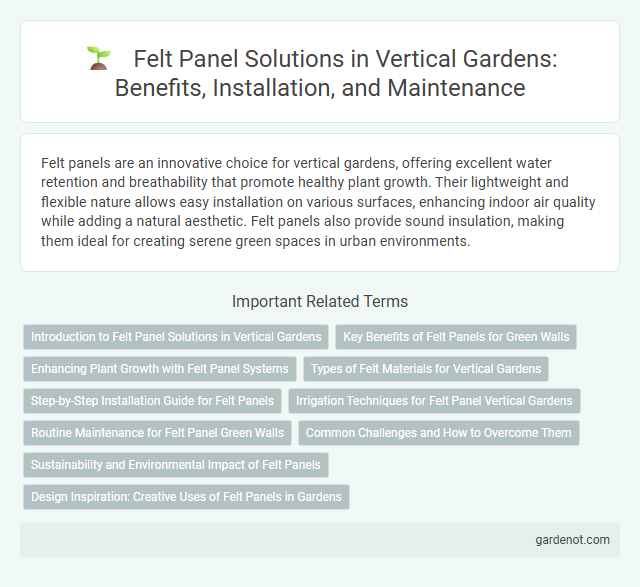Felt panels are an innovative choice for vertical gardens, offering excellent water retention and breathability that promote healthy plant growth. Their lightweight and flexible nature allows easy installation on various surfaces, enhancing indoor air quality while adding a natural aesthetic. Felt panels also provide sound insulation, making them ideal for creating serene green spaces in urban environments.
Introduction to Felt Panel Solutions in Vertical Gardens
Felt panels offer a sustainable and versatile solution for vertical gardens, providing excellent water retention and air circulation to support healthy plant growth. Made from natural or recycled fibers, these panels are lightweight, easy to install, and customizable to fit various wall sizes and designs. Their porous structure enhances moisture management, promoting a thriving green wall while adding insulation and soundproofing benefits to indoor and outdoor spaces.
Key Benefits of Felt Panels for Green Walls
Felt panels provide exceptional moisture retention that supports healthy plant growth in vertical gardens by maintaining consistent hydration levels. Their natural sound absorption qualities enhance indoor acoustic comfort, making green walls ideal for offices and residential spaces. Easy installation and sustainable composition from recycled materials contribute to eco-friendly vertical garden solutions with long-lasting durability.
Enhancing Plant Growth with Felt Panel Systems
Felt panel systems create an ideal microenvironment by retaining moisture and promoting consistent humidity, crucial for enhancing plant growth in vertical gardens. The breathable structure of felt allows airflow to roots while preventing waterlogging, supporting healthy root development and nutrient absorption. Integrating felt panels improves plant resilience and accelerates growth cycles, making them a sustainable choice for urban greening projects.
Types of Felt Materials for Vertical Gardens
Felt panels in vertical gardens are commonly made from natural wool, synthetic polyester, or a blend of both, each offering unique benefits in moisture retention and durability. Wool felt provides excellent water absorption and insulation, promoting healthy plant growth by maintaining humidity levels within the panel. Synthetic polyester felt resists mold and decay, making it suitable for outdoor installations exposed to varying weather conditions.
Step-by-Step Installation Guide for Felt Panels
Start the felt panel installation by selecting a sturdy frame or wall surface, ensuring it can support the weight of the vertical garden. Measure and cut the felt panels precisely to fit the designated area, then secure them using staples or adhesive suitable for outdoor or indoor conditions. Finally, plant the vegetation within the felt pockets, maintaining consistent moisture for optimum growth and stability.
Irrigation Techniques for Felt Panel Vertical Gardens
Felt panel vertical gardens utilize advanced irrigation techniques such as drip irrigation systems and capillary mats to ensure consistent moisture distribution across the entire surface. These systems optimize water use efficiency by delivering precise amounts directly to plant roots within the felt, minimizing runoff and evaporation. Integration of automated timers and moisture sensors further enhances irrigation control, promoting healthy plant growth and reducing maintenance requirements.
Routine Maintenance for Felt Panel Green Walls
Routine maintenance of felt panel green walls involves regular watering, ensuring the felt remains moist without oversaturation to promote healthy plant growth. Periodic cleaning of the felt surface prevents dust buildup, enhancing air circulation and plant photosynthesis. Inspecting for pests and trimming overgrown plants supports a vibrant and thriving vertical garden environment.
Common Challenges and How to Overcome Them
Felt panels in vertical gardens often face challenges such as moisture retention leading to mold growth and uneven water distribution causing plant stress. To overcome these issues, using high-quality, water-resistant felt material combined with proper irrigation systems ensures optimal moisture levels and prevents fungal problems. Regular maintenance and selecting felt panels with antimicrobial properties further enhance plant health and longevity in vertical garden installations.
Sustainability and Environmental Impact of Felt Panels
Felt panels used in vertical gardens are crafted from recycled natural fibers, significantly reducing waste and carbon footprint compared to synthetic alternatives. Their biodegradability ensures minimal environmental impact at the end of their lifecycle, promoting eco-friendly gardening practices. These panels also enhance urban air quality by supporting plant growth, contributing to sustainable green infrastructure.
Design Inspiration: Creative Uses of Felt Panels in Gardens
Felt panels bring innovative texture and vibrant color to vertical garden designs, offering a versatile medium for artistic expression. Their lightweight, breathable qualities support healthy plant growth while allowing customized shapes and patterns that transform outdoor spaces into living art installations. Designers often incorporate felt panels to create modular green walls, blending foliage with tactile elements that enhance both aesthetics and environmental benefits.
Felt panel Infographic

 gardenot.com
gardenot.com